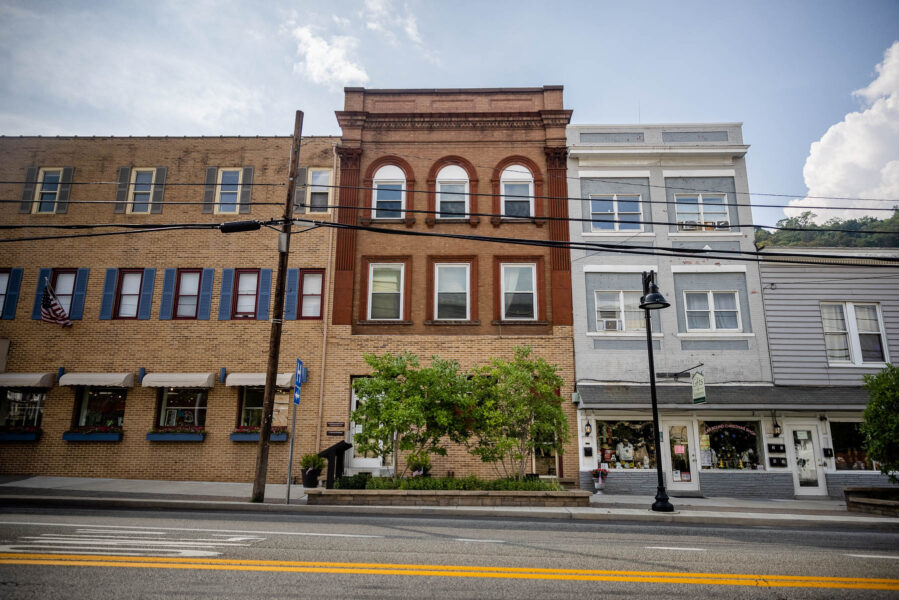West Virginia tourist town confronts flooding with green infrastructure

Go to the western edge of the Chesapeake Bay watershed to the rolling hills of West Virginia to find the small town of Berkeley Springs. The town is known as a relaxing vacation destination, but in the past few decades, the city has faced flooding issues that are anything but calming.
On a sunny day, the 11.9-mile tributary of the Potomac River that runs through Berkeley Springs is yet another charming draw. But during a storm, it can result in severe stormwater runoff, erosion and flooding issues. In fall 2012, a major flooding event forced the closure of many businesses along Berkeley Spring’s main street. Six inches of rain fell in about three hours—overwhelming the stormwater drains and covering downtown in mud and debris. The storm motivated the town to look for a solution.
Hoping to hold on to Berkeley Spring’s natural beauty, local leaders, along with the Region 9 Eastern Panhandle Regional Planning and Development Council, chose to use green infrastructure to reduce stormwater runoff in the town. As opposed to man-made structures that manage stormwater, such as drains, gutters and seawalls, green infrastructure include natural installations such as rain gardens and tree boxes that mimic the natural world. These projects not only reduce flooding but lessen the flow of harmful nutrients to the nearby tributary, which drains into the Potomac River and eventually the Chesapeake Bay.
By 2018, with the help of local and regional partnerships, Berkeley Springs had added new green infrastructure elements into already scheduled development projects—a cost-effective solution for the small town. The new elements included permeable pavers, tree boxes with bioretention cells and a rain garden at the bottom of a historic cemetery.
Permeable pavement
Businesses owners who remember the flooding that shut down their shops in 2012 can now rely on permeable pavement to help divert stormwater away from the town’s business zone. In contrast to impervious concrete and asphalt, permeable material soaks up water or allows it to pass through gaps between brick-like structures and into the ground. This lessens the flow of stormwater runoff that causes floods and reduces the amount of nutrient pollution entering nearby waterways. A variety of permeable pavement can be used in green infrastructure projects, including pervious concrete (which was used in Berkeley Springs), porous asphalt and spaced pavers with multiple levels of drainage. The type of permeable pavement used in a project can vary greatly depending on the needs of the area but all have a high level of success reducing stormwater runoff.
Tree boxes and bioretention cells
To divert even more rainfall from the town’s business zone, tree boxes and bioretention cells were installed along the main road. Bioretention cells are landscape installations that are designed to filter and absorb stormwater. They are densely planted with trees and vegetation that can handle long periods of saturation and include highly porous soil that allows more water to be absorbed at a faster rate. A single full-grown tree can absorb hundreds of gallons of stormwater each year, and its shade can help combat the urban heat island effect and thermal pollution. Tree boxes and bioretention cells also capture key contaminants like sediment, nitrogen and phosphorus.
Rain garden
A raingarden was installed at the historic Greenway Cemetery in Berkeley Springs to reduce flooding occurring on the property. Rain gardens are typically recessed areas with native trees and vegetation where stormwater is drained into. They slow the flow of rainwater, hold soil in place and absorb stormwater. Native plants and trees are particularly effective at absorbing excess stormwater because their roots often grow deeper than non-native species. As the root systems grow, they also create openings in the soil that allow stormwater to be absorbed. The trees and vegetation planted in rain gardens also provide food and habitat for wildlife while beautifying the area. In Berkeley Springs, that Greenway Cemetery rain garden has an educational signage to show people the environment benefits of the installation.
Since the completion of these green infrastructure projects, residents in the town have noticed improved stormwater management in the area near the restoration project and plan to implement similar projects in other parts of the town that still suffer from floods. In the future, the town hopes to install additional green infrastructure projects along other areas of the roadway to control more floodwater and prevent it from flowing directly into the local stream and ultimately the Chesapeake Bay.
Many of these green infrastructure projects can be installed on a smaller scale in homes and neighborhoods. If you’re interested in adding green infrastructure to your neighborhood, check out our webinar How Home Landscaping Projects Can Protect Local Waterways.

Comments
Just moved to Crisfield MD. This little town needs this program ASAP. I would like information on what steps I can take on my property so my soil isn’t wet 24/7.
Would love to know what plants to add to Absorb water. Thanks for the article any information. Look forward to getting more information.
Thank you!
Your comment has been received. Before it can be published, the comment will be reviewed by our team to ensure it adheres with our rules of engagement.
Back to recent stories